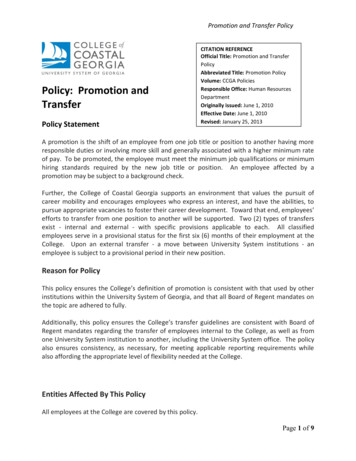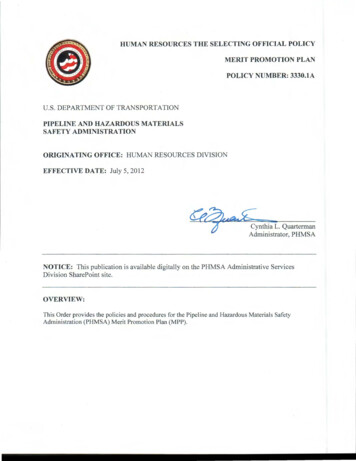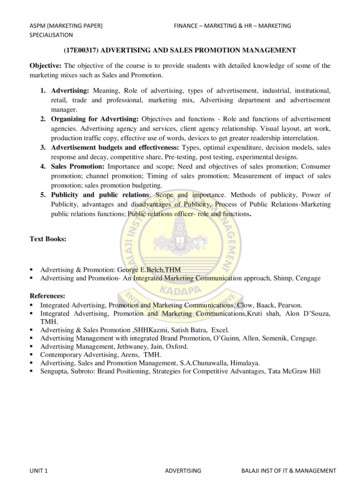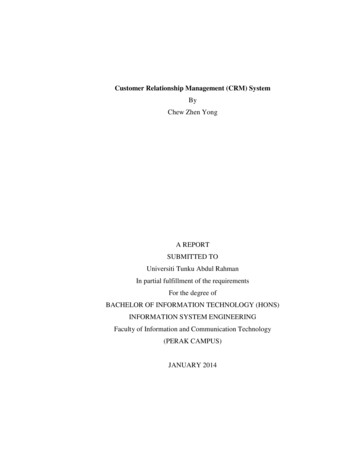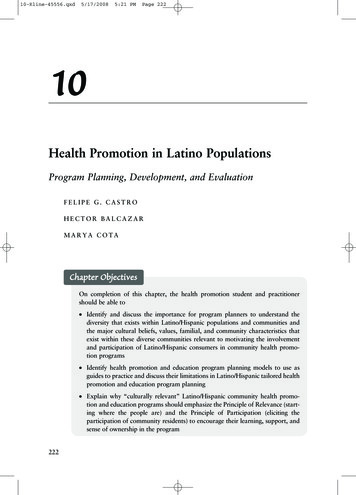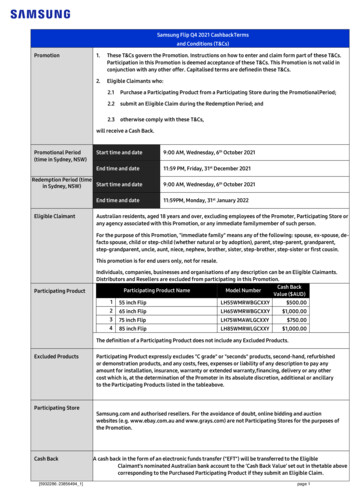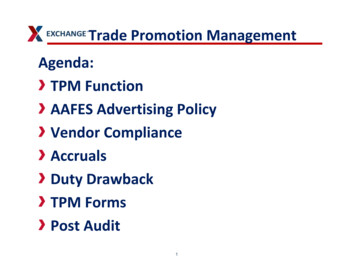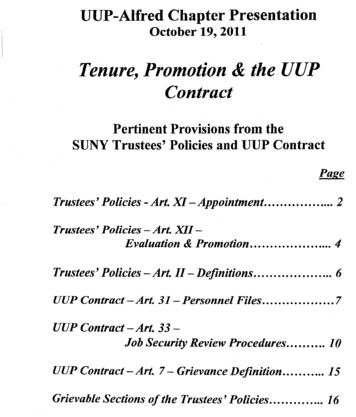
Transcription
GUIDELINESONEVALUATION, PROMOTION AND TENUREUNIVERSITY OF NORTH DAKOTASchool of Medicine & Health SciencesDeveloped and Approved, 1978-1979.Approved, Committee for Academic and Professional Qualification (CAPQ), 11-19-87Approved, Faculty Academic Council (FAC), 7-1-88; 9-11-95; 4-7-03; 1-20-06; 10-4-10; 2-04-13; 8-14-17INTRODUCTION"The primary purpose of the University of North Dakota School of Medicine and Health Sciences is to educate physiciansand other health professionals and to enhance the quality of life in North Dakota. Other purposes include the discovery ofknowledge that benefits the people of this state and enhances the quality of their lives." (Purpose Statement link)The quality of the UND School of Medicine and Health Sciences (hereafter “School” or “SMHS”) is sustained throughthe dedicated and creative work of the faculty. Thus, guidelines and procedures for faculty evaluations are establishedsuch that the performance of individual faculty members and their contributions may be equitably assessed, documentedand awarded. The all-encompassing purpose of evaluation is to improve the performance of the individual facultymember, thus contributing to the successes of the department, School, and University of North Dakota (hereafter “UND”or “University”).The School Guidelines on Evaluation, Promotion, and Tenure (hereafter “Guidelines”) address evaluation, promotion,and tenure policies and procedures within the School. The primary bases for the Guidelines have been the UniversityFaculty Handbook (Faculty Handbook link) and policies of the State Board of Higher Education (SBHE Policies link).GENERAL PRINCIPLES AND RESPONSIBILITIESBecause the School and its faculty have unique characteristics and responsibilities, there are portions of this document thatdiffer from the Faculty Handbook. For all matters not dealt with in the enclosed documents, the Faculty Handbook shouldbe used as the guide.Faculty Responsibilities:Each faculty member should be familiar with the University Faculty Handbook and the Guidelines.1
Administrator Responsibilities:The administrator should be familiar with UND Faculty Handbook and the Guidelines. The University administratorshould adhere to the following principles of democratic administration:1. Respect for individuals2. Faith in the power of human intelligence to solve problems3. The right of each individual affected by policy formation or alteration to have an equitable part in thedetermination of that policy4. The right to act through his or her chosen representatives5. The right to equality of opportunity6. The exercise of fairness7. The right of each individual to appeal decisions and actions affecting him or her and the right of theindividual to be informed of avenues of appealIn the exercise of these basic principles, the administrator should nurture an atmosphere of mutual trust and honesty basedon good communication (Faculty Handbook I-1, 1.2).Departmental Responsibilities:The Faculty Handbook I-4, 4.2 recognizes the uniqueness of individual faculty and the departments within which theyserve by stating that the main responsibility for implementation of evaluation has been placed in the departments.Accordingly, departments in the School will:1. Develop procedures for evaluation of faculty for promotion, tenure and post-tenure performances according tothe Guidelines.2. Develop criteria and expectations of achievement for promotion from rank to rank, for the awarding of tenure,and for post-tenure performance.Departmental criteria and expectations may be more rigorous but cannot be less rigorous than those describedin the Faculty Handbook and Guidelines. Each department may establish its own standards for the awarding oftenure as long as they are in conformity with the State Board of Higher Education (SBHE) tenure policies, theUniversity Constitution, Senate By-laws and recognized University-wide interpretations as recorded in theFaculty Handbook.3. Submit departmental standards and criteria and expectations for evaluation, promotion and tenure to the SchoolCPT for review and approval. Prior to submission, the standards and criteria must be approved by a majorityvote of all departmental academic faculty members, both tenured and non-tenured.2
4. Independently evaluate each dossier submitted. Review and make recommendations on promotion using onlythe approved criteria established by the department.5. Independently evaluate each dossier submitted. Review and make recommendations on the award of tenureusing only the approved criteria established by the department.6. Review and provide counsel regarding the credentials of individuals for appointment within faculty title seriesand rank.Committee on Evaluation, Promotion and Tenure (CPT) Responsibilities:The Faculty Handbook I-4, 4.2 recognizes the role of the department in reviewing departmental procedures, providingequity of assessment throughout the community. Accordingly, and as per the School Bylaws and the Faculty AcademicCouncil, the School Committee on Evaluation, Promotion, and Tenure (School CPT) will:1. Develop policy and procedure in the form of School Guidelines for conducting periodic performance reviewsand recommendations for promotion and tenure of faculty of the School. Such policies will be based uponguidance from the University Faculty Handbook. The Faculty Academic Council must approve proposedpolicies developed by the School CPT before they may be promulgated.2. Ensure that every department develops promotion and tenure guidelines for their faculty consistent with theSchool CPT Guidelines.3. Approve all departmental guidelines for promotion and tenure of faculty to ensure comparable processesthroughout the School and conformity with University and System rules, policies and procedures.4. Independently evaluate each dossier submitted to the School CPT. Review and make recommendations onpromotion using only the approved criteria established by the submitting department.5. Independently evaluate each dossier submitted to the School CPT. Review and make recommendations on theaward of tenure using only the approved criteria established by the submitting department.6. Review and provide counsel regarding the credentials of individuals for appointment within faculty title seriesand rank.The School CPT will define materials and documentation needed for probationary, promotion, tenure, and post-tenurereviews. The School CPT must base its evaluation and recommendations solely upon the information supplied by thefaculty member and department; it is imperative that the faculty member supply all necessary data and appropriatedocumentation. A fact cannot be assumed as known, if not stated.3
It is critical that promotion and the granting of tenure within the School be somewhat flexible because the unique needs ofa community-based medical education system involve individuals who bring widely varying backgrounds, philosophies,skills, opportunities and needs into an academic setting. Notwithstanding such uniqueness, promotions and tenure are tobe based on the consistency and quality of: Scholarly and creative activities, including distinctive, peer accepted contributions to one's discipline orprofession; Performances in teaching, including curriculum design, course development, content delivery, and assessment;and Service to the department, the School, the University, the profession, and society.Faculty members’ contributions to each of these areas may vary within the confines of a written job description andpercent of effort distributions. However, it is essential that chairs and faculty alike be aware that excelling in only oneaspect of academic responsibility may slow promotion (such as promotion from Assistant to Associate Professor) or maymake promotion impossible (such as promotion from Associate to Professor).Definitions of Scholarship, Scholarly Teaching, and ServiceScholarship: The School embraces the expanded view of scholarship proposed by Boyer (E. L. Boyer, ScholarshipReconsidered: Priorities of the Professoriate, Josey-Bass, 1990). Legitimate scholarly and creative pursuits encompass thescholarship of discovery (generating new knowledge through basic research); the scholarship of application or engagement(building bridges between theory and practice); the scholarship of integration (elucidating connections between differentdiscoveries); and the scholarship of teaching (evaluating the effectiveness of pedagogical approaches in promoting studentlearning).Certain characteristics and qualities define the essence of scholarship, whether in the area of teaching or other forms ofscholarly and creative activity. The School and its departments utilize the following criteria to define what we consider tobe the essential characteristics of scholarship: The faculty member’s efforts result in a tangible product or output (hereafter “work”); The work is made public and is available outside of the institution and region; The work is subjected to external peer review and critique by other scholars in the field; The work must be able to be reproduced and forms the foundation to be built on by other scholars.Teaching: Because School faculty members are expected to engage in scholarly teaching it is important to distinguish thisactivity from the Scholarship of Teaching noted previously.4
Scholarly teaching is teaching that is constantly evolving and improving. Scholarly teachers establish clear goals for thecourse, focusing on what students will learn rather than the content they will "cover". They prepare adequately, and theyresearch and use a variety of appropriate methods. They reflect on their own practice and invite critique on their teachingfrom students and peers, and administrators if appropriate. Their teaching results in significant student learning.(Adapted from: Activities of Scholarly Teachers. From The Centre for Discovery in Learning, University ofSaskatchewan)Service: Service includes contributions and activities that promote the general welfare of a department, the School, or theUniversity. Service also includes activities that contribute to the development of a professional discipline, a professionalsociety, or an outside agency or community. For all faculty members, regardless of appointment or rank, the concept of"service" includes displaying a collegial spirit of cooperation and avoidance of disruptive behavior. (Adapted from EmoryUniversity Faculty Handbook, Chapter 8: Service and Emory College of Arts and Sciences Principles and Procedures forPromotion and Tenure).FACULTY TITLESFaculty Titles:Faculty members with an academic appointment, scientist scholar, educator scholar or clinician scholar, contribute to themission of the School and UND in all three areas of scholarly and/or creative activity, teaching, and service. Anacademic appointment may be probationary, tenured, or special (non-tenured).Scientist ScholarThe Scientist Scholar designation is for faculty members with demonstrated excellence in the discovery and disseminationof new knowledge or new insights into existing knowledge. Scientist Scholars are effective teachers and activelyinvolved in academic or professional service.Educator ScholarThe Educator Scholar designation is for faculty members with demonstrated excellence in teaching, educationalleadership, curriculum development, faculty development, and/or administration. Faculty members in this title series areengaged in either the scholarship of teaching and learning, or scholarship/creative activities within their discipline orprofession. Educator Scholars are actively involved in academic or professional service.Clinician ScholarThe Clinician Scholar designation is for faculty members with demonstrated excellence in patient care, teaching, andadministrative service as well as scholarship and creative activities that typically relate to these areas. Clinician Scholarsare actively involved in academic or professional service.5
Additional Faculty Titles:Faculty members who actively contribute to the mission of the School in one or more primary areas of scholarly and/orcreative activity, teaching, and service may have a special appointment (non-tenured) in the following series:Research FacultyResearch faculty are dedicated to supporting the research mission of the school. These faculty members have a primaryfocus in research but may also contribute to other missions of the department.Teaching FacultyTeaching faculty are dedicated to supporting the teaching mission of the school. These faculty members have a primaryfocus in teaching but may also contribute to other missions of the department.Clinical FacultyClinical faculty are primarily clinicians who are or have been employed by regional health care systems or facilities.Their primary role is to contribute to the educational mission of the School although they may occasionally contribute tothe service, scholarship and administrative missions as well.Adjunct FacultyAdjunct faculty appointments are for individuals from business, industry, research institutions, government agencies, orother academic institutions. UND faculty or staff members who do not have a primary appointment at the School may alsobe eligible for an adjunct faculty appointment within the School. Adjunct faculty members help fulfill the educational,research, or service missions of the School.Joint FacultyJoint appointments are made for faculty members with a primary appointment in one department or discipline within theSchool or at the University who are actively contributing to the teaching or research mission of another department ordiscipline within the School or University.Emeritus FacultyEmeritus status may be conferred upon retirement or after retirement to faculty or senior administrators or professionalspursuant to institution policies and procedures. Criteria for emeritus status may include, but are not limited to, length ofservice to the institution, significant contributions to the institution and the State of North Dakota, or particularlydistinguished service to an academic discipline. Emeritus/emerita status shall not include salary or other compensation orother rights, except privileges specified in institution policies or procedures (SBHE Policy, 430.2).6
RANKS, CRITERIA FOR RANK, and CHARACTERISTICS of ACADEMIC RANK:SCIENTIST SCHOLAR, EDUCATOR SCHOLAR, and CLINICIAN SCHOLAR FACULTYRecognized RanksInstructorAssistant ProfessorAssociate ProfessorProfessorCriteria for RankThe candidate must meet the criteria of the department for the rank requested. Departmental criteria should meet, at least,the minimum standards of the School and University for the rank requested.Characteristics of Academic RankListed below are characteristics of rank in the academic title series of scientist scholar, educator scholar and clinicianscholar, used for appointment or promotion to Instructor, Assistant Professor, Associate Professor and Professor. Theseare intended to be the standard criteria and are not intended to exclude qualified candidates who possess equivalenttraining.InstructorEducation: Earned Bachelor’s degree, Master’s degree or equivalent training and/or Significant clinical experience commensurate with a terminal degreeExperience: Demonstrated potential as a teacher, researcher or both Engaged in professional developmentAssistant ProfessorEducation: Earned doctorate or other degree considered a terminal degree by the discipline, and/or Significant clinical experience commensurate with a terminal degreePostgraduate training:Postgraduate training criteria apply to Associate Professor and Professor ranks as well Faculty members with the M.D. degree should have completed residency training to board eligibility, ifappropriate Board certification in the discipline, if available or applicable Faculty members with the Ph.D. or other terminal degree will be expected to have completed postdoctoraltraining or equivalent experience, if appropriate in their area of specialization at the time of training Others should be eligible for professional certification in their fields, as available or applicable7
Experience: Demonstrated experience in teaching OR Demonstrated experience in scholarly and creative activity Demonstrated departmental and professional or community serviceAssociate ProfessorEducation: Earned doctoratePostgraduate training: As delineated for appointment as Assistant ProfessorExperience: Consistent and demonstrated effectiveness in teaching Scholarly and creative activity of appropriate quality and quantity for time in rank Local or regional recognition for scholarly activity Consistent and substantial contributions and service to their department, profession and schoolProfessorThe rank of Professor is awarded on the basis of documented recognition for continued superior performance andnot simply on the basis of time in rank as Associate Professor.Education: Earned doctoratePostgraduate training: As delineated for appointment as Assistant ProfessorExperience: Recognition for continued excellence in teaching National or international recognition for continued scholarly activity of high quality and appropriatequantity Demonstrated leadership and superior service contributions to the department, school and profession Recognition for professional and community serviceRANKS, CRITERIA FOR RANK, and CHARACTERISTICS of RANK:RESEARCH, TEACHING, AND CLINICAL FACULTY APPOINTMENTSResearch FacultyRecognized Research RanksResearch Assistant ProfessorResearch Associate ProfessorResearch Professor8
Criteria for Research RankIndividuals possessing appropriate degrees and whose primary area of emphasis is research and research-related activitieswithin biomedical, social, population, health or clinical sciences, may be eligible for a research rank. The researchfaculty member may participate in the educational activities of the department.A research faculty person may be a member of a Basic Science, Health Science, or Clinical Science department.Characteristics of Research RankResearch Assistant ProfessorEducation: Earned doctorate or other degree considered to be a terminal degree by the disciplinePostgraduate training:Postgraduate training criteria apply to Associate Professor and Professor ranks as well. Faculty members with the M.D. degree should have completed residency training to board eligibility, ifappropriate. Departments may, but are not mandated by this document to, require actual board certification. Faculty members with the Ph.D. or other terminal degree will be expected to have completed postdoctoraltraining or equivalent experience, if appropriate to their area of specialization at the time of training. Others should be eligible for professional certification in their fields, if such is available or applicable.Experience: Demonstrated ability in research Potential for effectiveness in departmental and professional serviceResearch Associate ProfessorEducation: Earned doctorate or other degree considered to be a terminal degree by the disciplinePostgraduate Training:As delineated for appointment as Research Assistant ProfessorExperience: Demonstrated record of excellence in research, either as a principal investigator or in support of a principalinvestigator Demonstrated research productivity as a contributor to the dissemination of research outcome throughpublication or presentation or other methods appropriate to the department Effectiveness in departmental and professional service9
Research ProfessorThe rank of Research Professor is awarded on the basis of documented recognition for continued superiorperformance and not simply on the basis of time in rank as Associate Professor.The individual must have demonstrated a leadership role in departmental activities and/or the professionaldiscipline.Education: Earned doctorate or other degree considered to be a terminal degree by the disciplinePostgraduate training: As delineated for appointment as Research Assistant ProfessorExperience: Evidence of being an independent investigator with extramural funding Evidence of maintaining a research program of high quality and appropriate quantity Demonstrated research productivity, i.e., publications including peer-reviewed articles, book chapters andinvited reviews. Recognition for continued contributions to the department and professionTeaching FacultyRecognized Teaching RanksTeaching InstructorTeaching Assistant ProfessorTeaching Associate ProfessorTeaching ProfessorCriteria for Teaching RankIndividuals possessing appropriate degrees and whose primary area of emphasis is teaching and teaching-related activitieswithin basic, social, population, health, or clinical science, may be eligible for a teaching rank. The teaching facultymember may participate in the research activities of the department.A teaching faculty person may be a member of a Basic Science, Health Science, or Clinical Science department.Characteristics of Teaching RanksTeaching Instructor:Education: Earned Bachelor’s degree, Master’s degree or equivalent training, and/or Significant teaching experience commensurate with a terminal degree Potential for effectiveness as a teacher10
Teaching Assistant ProfessorEducation: Earned doctorate or other degree considered to be a terminal degree by the discipline, and/or significantclinical experience commensurate with a terminal degree.Postgraduate training:Postgraduate training criteria apply to Associate Professor and Professor ranks as well. Faculty members with the M.D. degree should have completed residency training to board eligibility, ifappropriate. Departments may, but are not mandated by this document, require board certification Faculty members with the Ph.D. or other terminal degree will be expected to have completed postdoctoraltraining or equivalent experience, if appropriate to their area of specialization at the time of training. Others should be eligible for professional certification/licensure in their fields, if applicableExperience: Demonstrated ability in teaching with good student and/or peer evaluations Potential for effectiveness in scholarly and creative activity Potential for effectiveness in departmental and professional serviceTeaching Associate ProfessorEducation: Earned doctorate or other degree considered to be a terminal degree by the discipline, and/or significantclinical experience commensurate with a terminal degreePostgraduate Training:As delineated for appointment as a Teaching Assistant Professor.Experience: Demonstrated record of excellence in teaching with excellent student and/or peer evaluations Demonstrated teaching productivity Potential to assume leadership roles in education and curriculum development Demonstrated scholarly productivity in the area of education Demonstrated regional/national reputation in education Demonstrated effectiveness in Departmental, School, and professional serviceTeaching ProfessorThe rank of Teaching Professor is awarded on the basis of documented recognition for continued superiorperformance and not simply on the basis of time in rank as Teaching Associate Professor.Education: Earned doctorate or other degree considered to be a terminal degree by the discipline, and/or significantclinical experience commensurate with a terminal degree11
Postgraduate Training:As delineated for appointment as a Teaching Assistant Professor.Experience: Continued superior performance, achievement, and recognition as a scholarly teacher Demonstrated sustained scholarly productivity in the area of education Demonstrated leadership roles in education and curriculum development Evidence of funding Demonstrated leadership in departmental activities and/or the professional discipline Recognition for continued contributions to the Department, School and ProfessionClinical FacultyRecognized Clinical Faculty RanksClinical InstructorClinical Assistant ProfessorClinical Associate ProfessorClinical ProfessorCriteria for Clinical RankIndividuals possessing the appropriate degree(s) as defined by the clinical department and willing to contribute to themission of the School in one or more areas of teaching, scholarly activity and service may be eligible for a clinical rank.Characteristics of Clinical RankClinical Instructor Demonstrates potential as an educator Willing to engage in up to 100 hours per year teachingClinical Assistant Professor Board eligible or Board certified in his or her discipline, if applicable. Post degree experience, if applicable Demonstrated three years of teaching experience Engages in a minimum of 100 hours per year teaching or engaged in scholarly activityClinical Associate Professor Board certification (if applicable) Three or more years teaching or research experience Demonstrated teaching effectiveness Evidence of playing an important role in departmental teaching activities Engaged in 100 hours or more per year teaching or engaged in scholarly activity of high quality andappropriate quantity12
Clinical ProfessorDemonstrated leadership in departmental activities and/or the professional discipline Board certification (if applicable) Eight or more years of teaching or research experience Demonstrates effective teaching Engaged in 200 or more hours per year teaching or engaged in scholarly activity of high quality and withevidence of supportFACULTY RANKS, CRITERIA FOR RANK, AND CHARACTERISTICS OF RANK FORADJUNCT, JOINT, AND EMERITUS FACULTY APPOINTMENTSAdjunct FacultyRecognized RanksAdjunct InstructorAdjunct Assistant ProfessorAdjunct Associate ProfessorAdjunct ProfessorCriteria for Adjunct RankIndividuals possessing the appropriate degree for their profession from an accredited institution and who can demonstrateability in research, teaching, or clinical activity, depending on the proposed role as an adjunct faculty member may beeligible for appointment as an Adjunct Faculty member. The adjunct faculty member may be appointed from elsewhere inthe University or from the community at large.Characteristics of Adjunct RankAdjunct InstructorEducation: Earned Bachelor’s degree or equivalent trainingExperience: Demonstrated potential as a teacher or researcher Engaged in professional developmentAdjunct Assistant ProfessorEducation: Possession of a terminal degree for the professionExperience: Demonstrated ability in clinical activity, scholarly and/or creative activity or teaching, depending on theproposed role as an adjunct faculty member13
Adjunct Associate ProfessorEducation: Possession of a terminal degree for the professionExperience: Demonstrated sustained role in departmental educational activities in ONE or more of the following areas:direct teaching; advising or mentoring; learner assessment; the creation of educational materials. Local and regional recognition in research (if applicable) Demonstrated evidence of high impact and quality teaching in departmental educational or researchprograms Local and regional recognition in the practice of clinical specialty (if applicable) Demonstrated effectiveness in departmental and professional service Evaluations reflecting satisfactory performance by students, residents and other faculty membersAdjunct ProfessorEducation: Possession of a terminal degree for the professionExperience: Demonstrated high impact, high quality, and excellence in activities of direct teaching; advising ormentoring; learner assessment; or creation of educational materials Recognition as a role model, teacher and leader in educational practices Demonstrated and sustained scholarly activity within his or her discipline, and consistent with his or herrole as an adjunct faculty member Demonstrated leadership in clinical activity, teaching or research consistent with his or her role as anadjunct faculty member National or international recognition for clinical care, clinical or basic research, education, and/or service Demonstrated leadership in national and international organizationsJoint FacultyJoint Faculty RankJoint appointments reflect the contribution of the faculty member to the School and departments and may or may not be atthe same rank as the appointment in the home department.14
Criteria for a Joint FacultyIndividuals possessing the criteria for rank as defined by each department and who are willing to contribute to themissions of the School and Department in one or more areas of scholarly and/or creative activity, teaching, and servicemay be eligible for a joint rank.Emeritus FacultyEmeritus status may be conferred upon retirement or after retirement to faculty or senior administrators or professionalspursuant to institution policies and procedures. (Faculty Handbook I-3, 3.4).Emeritus Faculty RankEquivalent to the rank at which the faculty member was appointed prior to retirement.Criteria for Emeritus FacultyCriteria for emeritus status may include, but are not limited to, length of service to the institution, significant contributionsto the institution and the State of North Dakota, or particularly distinguished service to an academic discipline.FACULTY APPOINTMENTS and CONTRACTSFaculty appointments shall be probationary, tenured, or special (non-tenured) (Faculty Handbook I-8, 8.1.1, 4; SBHEPolicy 605.1, 4).Probationary Appointments entail tenure-track contracts. Probationary contracts of the faculty of the School will be basedon two criteria: source of funding and academic rank, i.e., in order for faculty members to be considered tenure eligible,they must1. Be initially (or subsequently) fully funded from State General Fund appropriations available for thatindividual’s tenured salary, and2. Carry a probationary academic faculty rank (instructor, assistant professor, associate professor or professor).Failure to satisfy both of these conditions simultaneously prevents issuance of a probationary contract. (Faculty Handboo
UNIVERSITY OF NORTH DAKOTA School of Medicine & Health Sciences Developed and Approved, 1978-1979. . Service and Emory College of Arts and Sciences Principles and Procedures for Promotion and Tenure ). FACULTY TITLES . . Adjunct faculty appointments are for individuals from business, industry, research institutions, government agencies, or


